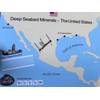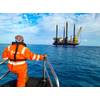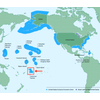Changing Climate, Oceans and America’s Fisheries
Across America, changes in climate and oceans are having very real and profound effects on communities, businesses and the natural resources we depend on, according to Dr. Richard Merrick is the chief scientist for NOAA’s National Marine Fisheries Service.
Fishing communities face extra challenges, as droughts, floods, rising seas, ocean acidification, and warming oceans change the productivity of our waters and where wildlife live, spawn and feed. And there is much at risk – marine fisheries and seafood industries support over $200 billion in economic activity and 1.83 million jobs annually.
NOAA last year set out a national strategy to help scientists, fishermen, managers and coastal businesses better understand what’s changing, what’s at risk and what actions are needed to safeguard America’s valuable marine resources and the revenues, jobs and communities that depend on them. Today, NOAA released regional action plans with specific actions to better track changing conditions, provide better forecasts, and identify the best strategies to reduce impacts and sustain our marine resources for current and future generations. Implementing these actions will give decision-makers the information they need now to sustain our vital marine resources and the many people that depend on them every day.
We are seeing dramatic changes, particularly in cooler-ocean regions like New England and Alaska where warming waters over the last twenty years are pushing fish northward or deeper to stay in cooler waters. In New England, known for its cod and lobster fishing, ocean temperatures have risen faster than many other parts of the world. Changes in the distribution and abundance of these and other species have affected where, when and what fishermen catch, with economic impacts rippling into the coastal communities and seafood businesses that depend on them. With better information on current and future shifts in fish stocks, fisheries managers and fishing industries can better plan for and respond to changing ocean conditions.
But not all change is bad: As southern fish species like black sea bass spread northward along the East Coast, they may provide opportunities for additional commercial or recreational fisheries. Changing conditions may also stimulate more opportunities for other marine related businesses, such as fish and shellfish farming. Better information on when, where and how marine resources are changing is critical to taking advantage of future opportunities and increasing the resilience of our fisheries and fishing-communities.
Communities and economies in southern states are also being impacted by changing climate and ocean conditions. Louisiana loses a football field size area of coastal wetlands to the sea every hour due to rising seas and sinking lands. The loss of these essential nursery areas for shrimp, oysters, crabs and many other commercial or recreationally important seafood species has significant impacts on fisheries, seafood industries and coastal communities. Better information and on-the-ground action can reduce these impacts and help sustain these vital habitats and the many benefits they provide.
In the Pacific and Caribbean, we’re seeing bleaching and destruction of vitally-important coral reef environments associated with warming seas. Covering only one percent of the planet, coral reefs are the home to 25 percent of all marine species, and upwards of 40 billion people rely on coral reefs for the fish and shellfish they eat. The loss of coral reefs also makes coastal communities more vulnerable to storm events. Coral reefs in Puerto Rico, for instance, help prevent an estimated $94 million in flood damages every year. NOAA’s Coral Bleaching Early Warning System has already helped decision-makers take action to try and increase resilience of valuable reef ecosystems to warming seas and other threats.
While these challenges may seem daunting, with better information on what’s changing, what’s at risk and how to respond decision-makers can find ways to reduce impacts, increase resilience and sustain America’s vital marine resources and the millions of people who depend on them.
We are committed to sustaining the nation’s valuable marine resources and the many people, businesses and communities that depend on them for generations to come.













 February 2025
February 2025



